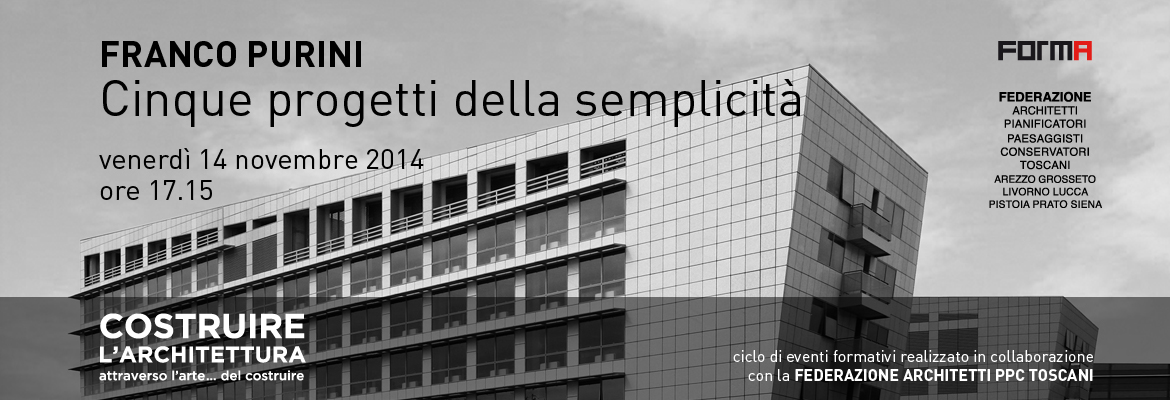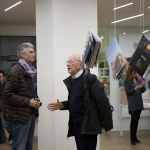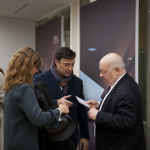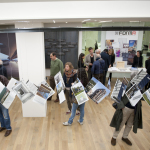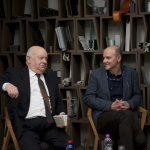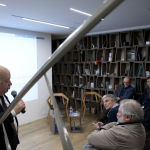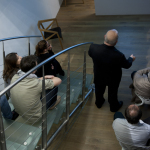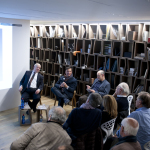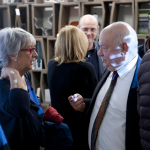Venerdì – 14 novembre 2014 – ore 17.15
Costruire l’architettura: Franco Purini “Cinque progetti della semplicità”
Franco Purini
Prosternator qualifica il senso del tempo nel linguaggio di Leon Battista Alberti: pervicax rerum prosternator, “inflessibile distruttore delle cose”. Nella traduzione del De re aedificatoria, Françoise Choay lo considera «un magnifique néologisme». Da «colui che abbatte e annienta» (celui qui abat et anéantit) trae origine l’arte. Le opere dell’uomo ne sono pervase, e se vi si riflette con la dovuta attenzione, in un duplice e contrario senso: il tempo è il presupposto della distruzione e insieme della costruzione.
Quel pensatore-architetto, riconosciuto grande dalla cultura internazionale dell’archittura, che è Franco Purini, ha evocato la terribile senzazione di violenza che si prova alla vista della voragine aperta nella terra dallo scavo delle fondazioni. La costruzione nasce da un atto violento, si fonda su un’operazione distruttiva. Non diversamente pensa Le Corbusier quando in Urbanisme (1925) afferma lapidario: «La ville est la mainmise dell’home sur la nature», «C’est une action humaine contre la nature», ossia una manomissione violenta, un atto contro la natura.
Ma, insieme, quell’opera dell’arte che chiamiamo Architettura è tale, da sempre, se è un «antemurale del tempo», se vi si oppone. È questo il «credo» dichiarato di Purini e la cifra fondante il suo progetto, ossia la dimensione concettuale, da egli privilegiata, che sta prima dell’opera e la fonda. È il tema universale di ogni tema particolare che ossessivamente, pervicacemente (pervicax) va riproposto, perché si abbia Architettura.
Tuttavia la resa al tempo distruttivo sembra oggi prevalere nella cifra di molteplici orientamenti, al punto da condurre alla scomparsa dell’Architettura. Individualismo di massa. Caduta dell’essenza collettiva della città e diluizione nel generico urbano in confusione col territorio, il paesaggio, l’ambiente. Eclissi del rapporto strutturale architettura-città. Tramonto della critica architettonica. Trasfigurazione dell’architettura in oggetto di design collocabile ovunque. Appiattimento sul presente, perdita di senso della storia e disimpegno dalla previsione del futuro. Pervasività delle tecnologie telematiche e crisi dello spazio-tempo nei non-luoghi. Primato degli specialismi e della tecnica, che da mezzo si rovescia in fine.
I cinque progetti dello Studio Purini-Thermes, con la loro gemetria severa e il loro linguaggio compositivo «semplice», perché opposto alla finta complessità dell’oggi, mettono invece in evidenza, con immediatezza, l’«antemurale» in cui l’Architettura consiste e che in Italia trova ancora patria. La «semplicità» del progetto puriniano è tale, perché indica con chiarezza e rigore, all’osservatore non distratto, la complessità autentica, costituita in ultimo della complessa struttura del tempo: il suo aprire lo spazio al lasciarsi negare e insieme il suo negare tutto ciò che intende negarlo.
Francesco Ventura
Friday – nov 14th 2014 – 17.15 pm
Building the architecture: Franco Purini “Five designs of simplicity”
Franco Purini
Prosternator qualifies the sense of time in Leon Battista Alberti’s words: pervicax rerum prosternator the “relentless destroyer of things.” In De re aedificatoria‘s translation, Françoise Choay calls it “un magnifique néologisme.” Art originates from “that which breaks down and destroys” (celui qui abat et anéantit). Human works are pervaded with it, and if we reflect it due attention, in a dual, opposing sense, time is the precondition for destruction and for construction.
Franco Purini — the thinker/architect whose greatness is recognized by architectural culture internationally — has evoked the terrible sense of violence that we experience seeing a chasm open in the ground when foundations’ are dug. Construction is born of a violent act. It is based on a destructive action. Le Corbusier was of a similar opinion, succinctly stating in Urbanisme (1925): “Une ville! C’est la mainmise de l’homme sur la nature,” “C’est une action humaine contre la nature” — a violent tampering, an act against nature.
But, ultimately, the work of art that we call Architecture has always been such only if it is a “bulwark of time,” opposing it. This is the “credo” that Purini has stated and is the code of his design, the conceptual dimension that he favors, coming before the work and grounding it. This is the universal theme of each specific theme that is obsessively, relentlessly (pervicax) repeated so that we have Architecture.
However, giving in to destructive time seems to prevail in the codes of many works, to the point of leading to the disappearance of Architecture. Mass individualism. The decline of the city’s collective essence and its dilution in the generic urban jumble of place, landscape, and environment. The eclipse of the structural relationship between architecture and city. The decline of architectural criticism. The transfiguration of architecture into an object that can be set anywhere. The flattening on the present, the loss of the sense of history and the disengagement from envisioning the future. The pervasiveness of telecommunication technologies and the crisis of space/time in non-places. The dominance of specialization and technology, of means become the ends.
The five designs by Studio Purini-Thermes have their severe forms and “simple” compositional language, which is simple because opposed to today’s false complexity. This is how they highlight — with immediacy — the “bulwark” that is Architecture and of which Italy is still the native land. The “simplicity” of Purini’s design is such because it clearly and precisely shows observers who are paying attention authentic complexity — consisting ultimately in the complex structure of time — its of opening space, to let itself be denied while denying everything that intends to deny it.
Francesco Ventura
-
© Valentina Muscedra
-
© Valentina Muscedra
-
© Valentina Muscedra
-
© Valentina Muscedra
-
© Valentina Muscedra
-
© Valentina Muscedra
-
© Valentina Muscedra
-
© Valentina Muscedra
